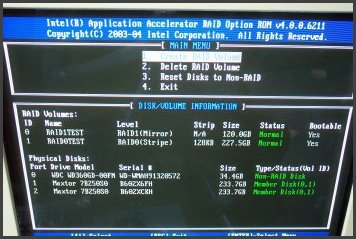Intel's Matrix Storage Technology
Intel's new SATA controller on the ICH6 is a step forward from what was available on ICH5. The RAID variant in particular gives us plenty to talk about. The bridge supports four ports natively with the ability to hang another pair from the bridge using an external PHY. Production boards from partners are specifying either 4 native ports or 8, the other quartet supplied by a completely separate processor, usually from Silicon Image, hanging off the ICH6's PCI bus interface.Native Command Queueing
The ports support Native Command Queueing, a method of reordering commands as they're sent from the SATA host to the drive, so that the drive can more effectively return or save the data that the host is asking for or supplying. Say that the host asks for 4 separate pieces of data, sequentially using SATA commands, on a connected disk, numbered 1, 2, 3 and 4. Then assume that as the hard disk spins internally, the data will arrive at the read head on the disk in the order 4-2-1-3. The host with NCQ support, using a connected disk that also supports NCQ, can arbitrate those read requests so they're performed on the disk in the correct order for the fastest turnaround, 4-2-1-3.NCQ therefore effectively seeks to hide rotational latency by reordering the commands as they arrive at the disk. It's theoretically a large boost to overall hard disk performance. Expect to see all new SATA controllers, not just the ICH6, support NCQ.
I'll cover disk performance later.
RAID
The RAID controller enhancements are the most exciting part of the Matrix Storage group of technologies. The controller is now able to create separate RAID volumes on the same set of disks. For example, hooking up two disks will allow you to create any mix of RAID0 and RAID1 volumes on those disks, in as much disk space as the disks will allow.For example, you can create a RAID array using a pair of disks, creating a RAID0 volume at the start of the available space for extra performance over a single disk configuration, while creating a further RAID1 volume in the remaining space on the same disk pair, for data security.
The ability to mix RAID volumes on a single array is a new feature for desktop hardware from any vendor.
Here's a photograph of the ICH6 SATA BIOS on the 925X reference board. It shows a Western Digital Raptor boot disk with a pair of Maxtor 250GB disks connected, hosting both RAID0 and RAID1 volumes.
Any and all RAID volumes created on the disk can be marked as bootable, allowing you to boot any operating system that supports the ICH6R from any created volume defined on the controller.
Summary
Native Command Queueing and mixed RAID volumes are the biggest feature enhancements on the ICH6 series, compared to ICH5 and other SATA controllers. With performance enhanced in single disk, non-RAID modes, and in RAID0 and RAID1 modes too, the controller gets a fine overhaul for the new Intel processor platform.Of course the disk controller also supports a pair of regular ATA channels for connection of up to four legacy disks or optical drives, with those channels supplanted in favour of SATA when you add the external PHY.










